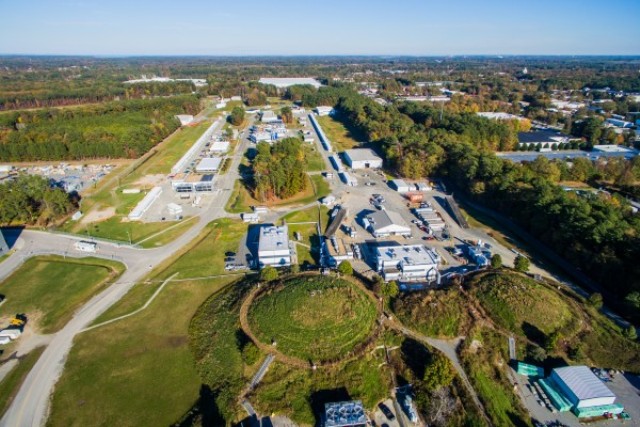Dec 23 2015
The newly upgraded accelerator at the U.S. Department of Energy's Thomas Jefferson National Accelerator Facility has delivered full-energy electrons as part of commissioning activities for the ongoing 12 GeV Upgrade project. At 4:20 p.m. on Monday, Dec. 14, operators of the Continuous Electron Beam Accelerator Facility (CEBAF) delivered the first batch of 12 GeV electrons (12.065 GeV) to its newest experimental hall complex, Hall D.
 On December 14, full-energy 12 GeV electron beam was provided for the first time, to the Experimental Hall D complex, located in the upper, left corner of this aerial photo of the Continuous Electron Beam Accelerator Facility. Hall D is the new experimental research facility – added to CEBAF as part of the 12 GeV Upgrade project. Beam was also delivered to Hall A (dome in the lower left). Credit: DOE's Jefferson Lab
On December 14, full-energy 12 GeV electron beam was provided for the first time, to the Experimental Hall D complex, located in the upper, left corner of this aerial photo of the Continuous Electron Beam Accelerator Facility. Hall D is the new experimental research facility – added to CEBAF as part of the 12 GeV Upgrade project. Beam was also delivered to Hall A (dome in the lower left). Credit: DOE's Jefferson Lab
“Through part of the ongoing upgrade process, we have refurbished or replaced virtually every one of the many thousands of components in CEBAF," said Allison Lung, deputy project manager for the CEBAF 12 GeV Upgrade project and Jefferson Lab assistant director. “Now, to see the machine already reaching its top design energy – It’s a testament to the hard work of the many Jefferson Lab staff members who have made it possible.”
The 12 GeV Upgrade project, which is scheduled to be completed in September 2017, was designed to enable the machine to provide 12 GeV electrons, which is triple its original design and double its maximum operational energy before the upgrade. By increasing the energy of the electrons, scientists are increasing the resolution of the CEBAF microscope for probing ever more deeply into the nucleus of the atom. The $338 million upgrade entails adding ten new acceleration modules and support equipment to CEBAF, as well as construction of a fourth experimental hall, upgrades to instrumentation in the existing halls, and other upgrade components.
“The CEBAF accelerator commissioning and achievement of the design energy required hard work, patience and teamwork,” said Arne Freyberger, Jefferson Lab’s director of accelerator operations. “It's just fantastic to watch it all come together, and the sense of accomplishment is palpable.”
Once the upgrade is complete, CEBAF will become an unprecedented tool for the study of the basic building blocks of the visible universe. It will be able to deliver 11 GeV electrons into its original experimental areas, Halls A, B and C for experiments. The full-energy, 12 GeV electrons are now being provided to the Experimental Hall D complex to initiate studies of the force that glues matter together. In Hall D, scientists hope to produce new particles, called hybrid mesons. Hybrid mesons are made of quarks bound together by the strong force, the same building blocks of protons and neutrons, but in hybrid mesons, this force is somewhat modified. It’s hoped that observing these hybrid mesons and revealing their properties will offer a new window into the inner workings of matter.
“This kind of science explores the most fundamental mysteries: Why are we here? Why is it that one particular combination of quarks and forces takes on that material property, while a different combination of quarks and forces makes up the human body?” Lung said. “One particularly compelling question that scientists have had, is why do we always find quarks bound together in two and threes, but never alone? We will have an entirely unique facility designed to answer the question.”
Jefferson Lab is a world-leading nuclear physics research laboratory devoted to the study of the building blocks of matter inside the atom's nucleus – quarks and gluons – that make up 99 percent of the mass of our visible universe. Jefferson Science Associates, LLC, a joint venture of the Southeastern Universities Research Association, Inc. and PAE Applied Technologies, manages and operates the Thomas Jefferson National Accelerator Facility, or Jefferson Lab, for the U.S. Department of Energy's Office of Science.
DOE’s Office of Science is the single largest supporter of basic research in the physical sciences in the United States, and is working to address some of the most pressing challenges of our time. For more information, visit science.energy.gov.